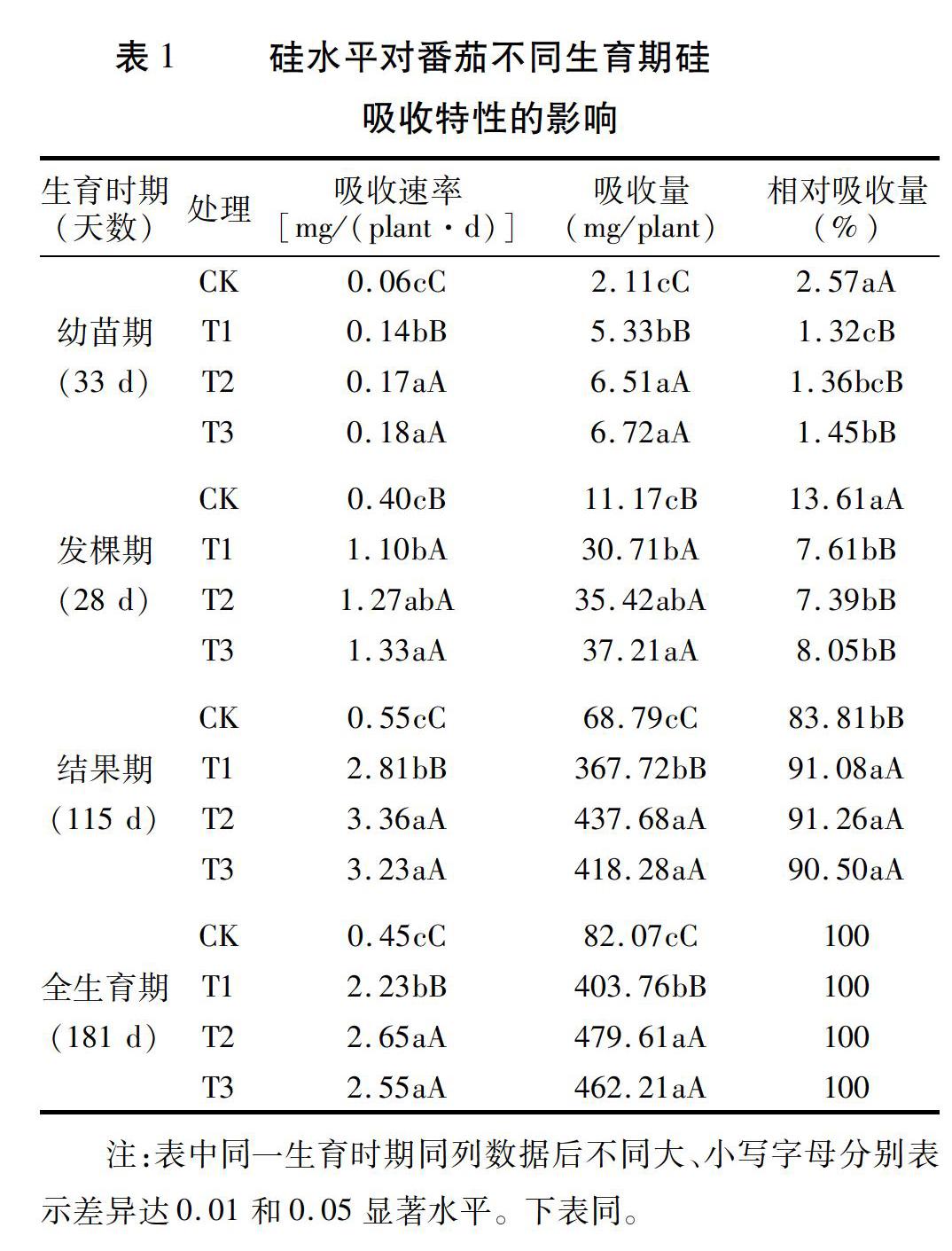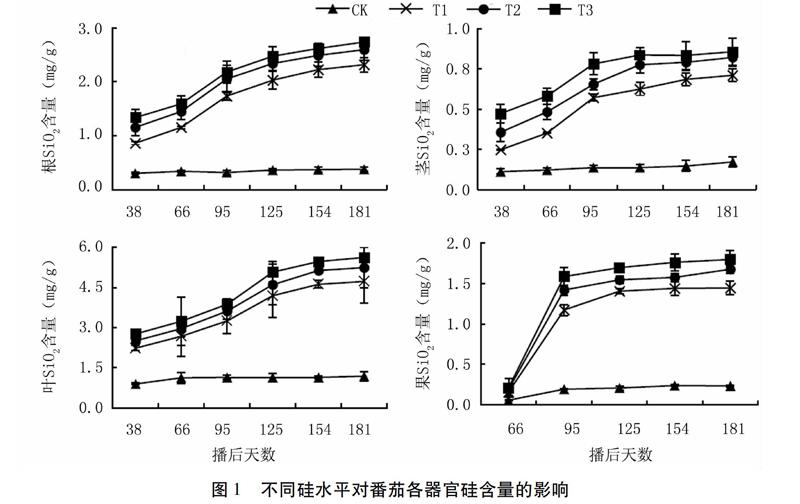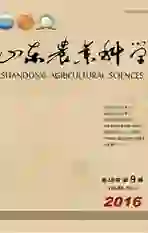硅对番茄果实发育及硅吸收特性的影响
2016-10-14高荣广曹逼力
高荣广 曹逼力


摘要:为探讨硅对番茄的生理效应,本试验采用水培方式,研究了营养液硅水平对番茄果实发育及硅吸收分配规律的影响。结果表明,与对照(CK)相比,随营养液硅水平的提高,番茄植株各器官硅吸收量显著增加,果实成熟期缩短2~3天,坐果数及单株产量增加,但单果质量下降;硅水平过高(1.8 mmol/L)不利于植株生长,单株产量以1.2 mmol/L硅处理最高,较对照增产15.22%。提高营养液硅水平,显著提高了番茄植株硅含量、吸收速率和吸收积累量,全生育期植株硅含量均以叶片较高,根次之,果实及茎较低,且各器官硅含量随植株生长逐渐增加,硅吸收速率显著增强,至结果盛期达最高。
关键词:硅;番茄;植株生长;吸收;产量
中图分类号:S641.206+.2文献标识号:A文章编号:1001-4942(2016)09-0088-04
AbstractIn order to investigate the effects of silicon on physiological characteristics of tomato(Solanum lycopersicum L.), the effects of silicon on fruit development and silicon absorption and distribution were studied using hydroponic experiments. The results showed that the increase of silicon level in culture solution caused the significant increase of silicon absorption of every organs, decrease of fruit mature period by 2~3 days, increase of fruit setting number and single plant yield, and decrease of single fruit mass. The growth trend of tomato plant under too high silicon level (1.8 mmol/L) was weakened. The yield of tomato under suitable silicon level (1.2 mmol/L) was the highest, which increased by 15.22% compared with the control. The increase of silicon level in culture solution also resulted in the increase of content, absorption rate and accumulation of silicon in tomato plants. The silicon content in leaves was the most abundant, followed by root, while that in fruit and stem was lower. The growth and development of plants led to gradually increase of silicon content in every organ and significantly enhancement of silicon absorption rate, which reached to the peak at fruit flourish stage.
KeywordsSilicon; Tomato; Plant growth and development; Absorption; Yield
硅是土壤中第二豐富的元素,多以硅酸盐结晶或沉淀形式存在,能被植物吸收利用的有效硅含量较低。植物中的硅多以二氧化硅胶(SiO2·nH2O)形态分布于表皮细胞和细胞壁,但物种间硅含量存在较大差异[1]。尽管如此,大量研究表明,硅可显著改善植物的生长发育、形态结构、产量及防病抗逆能力,被公认为植物的有益元素[2]。近年来,硅对植物影响的研究多集中在水稻、小麦、高粱等较喜硅的单子叶植物上。由于双子叶植物体内的硅积累量较少,因此硅对双子叶植物生长发育的影响未引起足够重视,但硅对棉花[3]、黄瓜[4]幼苗的促生长作用已被证实。
番茄(Solanum lycopersicum L.)属茄科番茄属,为双子叶植物,是我国设施栽培面积最大的蔬菜之一。研究发现,施适量的硅可提高番茄幼苗各器官的硅含量、叶片色素含量和光合速率,降低蒸腾速率[5];Al-aghabary等[6]和Romero-Aranda等[7]研究也表明,硅可提高番茄对盐胁迫的耐受性。梁永超等[8]研究表明,施硅番茄的始花期提早了4天,花序结果数也显著增加。但关于番茄对硅吸收特性的研究鲜见报道。因此,本试验研究了不同硅水平对水培番茄硅吸收特性及产量的影响,旨在为番茄合理增施硅肥提供理论依据。
1材料与方法
1.1试验材料
试验于2014年在山东农业大学蔬菜试验站日光温室内进行。供试番茄品种为‘金棚1号,用无硅水配制的Hoagland营养液水培育苗,至8叶1心时定植于PVC栽培槽内,继续以Hoagland营养液进行水培。栽培槽长6 m,槽间距80 cm,每处理两槽,每槽栽植番茄16株。
1.2试验设计
试验设4个硅素(Si)水平,分别为:0(CK)、0.6 mmol/L(T1)、1.2 mmol/L(T2)、1.8 mmol/L(T3),每个处理重复3次。试验用无硅水由广东仟净公司生产,硅含量小于8.3×10-5 mmol/L,所用硅源为Na2SiO3·9H2O,通过加入Na2SO4平衡不同处理营养液的Na+含量和渗透势,营养液pH值用0.01 mol/L的H2SO4和NaOH调至6.0左右。试验过程中,通过测定营养液电导率变化情况,每3~5天更换一次营养液。
1.3测定项目及方法
分别于播种后第38、66、95、125、154、181天取样,各处理每次取3~5株,将根、茎、叶、果分开,置干燥箱中105℃杀青30 min,75℃烘干至恒重称量干质量,并以Vorm法[9]测定其硅含量,并计算植株硅吸收量(硅含量与干物质量乘积的总和)、吸收速率(单位时间内的硅吸收量)及相对吸收量(某生育期硅吸收量占全生育期吸收量的比例)。此外,每处理选取10株,自果实成熟采收时开始,分别计算产量,直至拉秧。
1.4数据处理
采用Microsoft Excel 2003软件对试验数据进行处理和作图,采用DPS 7.5软件进行统计分析和Duncans新复极差法进行处理间差异显著性检验。
2结果与分析
2.1硅水平对番茄不同器官硅含量的影响
前期增加显著,而CK番茄各器官硅含量较低且基本稳定。幼苗期(第38天)T1、T2、T3处理的根系硅含量分别较CK高 1.82、2.77倍和3.35倍,结果盛期(第154天)则分别高4.99、5.71倍和 6.07倍。同一处理番茄植株硅含量以叶片较高,根次之,果实和茎较低,如结果前期(第95天),T2的根、茎、叶、果实硅含量分别达2.05、0.65、3.61、1.42 mg/g,即使未施硅(CK)时,其叶片硅含量也达1.14 mg/g,分别比根、茎、果实高2.56、7.44、4.87倍。CK植株各器官含少量的硅,可能与配制营养液的无硅水含微量硅有关。
2.2硅水平对不同生育期番茄硅吸收特性的影响
2.3硅水平对番茄果实发育及产量的影响
3讨论与结论
Nikolic等[10]研究发现,硅以被动扩散方式随质流进入番茄根部皮层,通过运载体介导进入质外体。但由于番茄吸硅速率小于吸水速率,且茎伤流液硅浓度低于外部培养液,因此认为番茄属硅排斥吸收类型,硅吸收能力较弱,但番茄植株平均硅含量仍达0.2%左右,且吸收量随供硅水平的提高而增加[11,12]。梁永超等[8]研究表明,施硅番茄植株茎叶硅含量显著高于对照。Jones等[13]研究表明,禾谷类作物硅沉积量依次为花序>叶片>叶鞘>茎秆>地下部;张国芹等[14]研究表明,生姜植株硅含量以叶片与根系较高,地下根茎次之,地上茎较低;McNaughton等[15]发现,非洲草含硅量从根到地上部逐渐减少,表明不同植物硅沉积与分配的主要器官存在显著差异。本试验结果表明,随营养液硅水平的升高,番茄植株根、莖、叶、果实中硅含量均显著增加,且各器官含硅量均随植株生长呈增加趋势,但硅含量以叶及根较高,果实及茎较低。
前人研究表明,硅可提高水稻根系生物量,增加根系活力,促进水分和养分的吸收[16],硅也可调节水稻植株C/N比例,改善初级代谢,提高水稻产量[17]。甜瓜施硅则开花期提早,前期产量增加[18];施硅也促进了马铃薯试管苗生长[19]。本试验结果表明,随硅水平提高,番茄植株生物量增加,果实产量显著提高,但硅水平过高(1.8 mmol/L),则不利于番茄植株生长。此外,施硅处理还显著提早了番茄开花坐果时间,缩短了果实成熟天数,这与梁永超等[8]的研究结果一致。
参考文献:
[1]Ma J F, Miyake Y, Takahashi E. Silicon as a beneficial element for crop plants [J]. Silicon in Agriculture, 2001,8:17-39.
[2]Liang Y C, Sun W, Zhu Y G, et al. Mechanisms of silicon-mediated alleviation of abiotic stresses in higher plants: a review[J]. Environmental Pollution, 2007, 147(2): 422-428.
[3]李清芳, 马成仓. 土壤有效硅对棉花幼苗营养代谢的影响[J]. 中国农业科学, 2003, 36(6): 726-730.
[4]李清芳, 马成仓.土壤有效硅对黄瓜种子萌发和幼苗生长代谢的影响[J]. 园艺学报, 2002, 29(5): 433-437.
[5]曹逼力, 徐坤, 石健, 等. 硅对番茄生长及光合作用与蒸腾作用的影响[J]. 植物营养与肥料学报, 2012, 19(2): 354-360.
[6]Al-Aghabary K, Zhu Z, Shi Q. Influence of silicon supply on chlorophyll content, chlorophyll fluorescence, and antioxidative enzyme activities in tomato plants under salt stress [J]. Journal of Plant Nutrition, 2004, 27(12): 2101-2115.
[7]Romero-Aranda M R, Jurado O, Cuartero J. Silicon alleviates the deleterious salt effect on tomato plant growth by improving plant water status [J]. Journal of Plant Physiology, 2006, 163(8): 847-855.
[8]梁永超, 陈兴华, 马同生,等. 硅对番茄生长、产量与品质的影响[J]. 江苏农业科学, 1993(4): 48-50.
[9]van der Vorm P D J. Dry ashing of plant material and dissolution of the ash in HF for the colorimatric determination of silicon[J]. Communications in Soil Science and Plant Analysis, 1987, 18(11): 1181-1189.
[10]Nikolic M, Nikolic N, Liang Y, et al. Germanium-68 as an adequate tracer for silicon transport in plants: characterization of silicon uptake in different crop species[J]. Plant Physiology, 2007, 143(1): 495-503.
[11]Takahashi E, Ma J F, Miyake Y. The possibility of silicon as an essential element for higher plants[J]. Comments on Agricultural and Food Chemistry, 1990,2(2):99-122.
[12]Heine G, Tikum G, Horst W J. Silicon nutrition of tomato and bitter gourd with special emphasis on silicon distribution in root fractions[J]. Journal of Plant Nutrition and Soil Science, 2005, 168(4): 600-606.
[13]Jones L H P, Handreck K A.Silica in soils, plants and animals [J]. Aadvances in Agronomy, 1967, 19(1): 107-149.
[14]张国芹, 徐坤, 王兴翠, 等. 硅对生姜叶片水、二氧化碳交换特性的影响[J]. 应用生态学报, 2008, 19(8): 1702-1707.
[15]McNaughton S J, Tarrants J L. Grass leaf silicification: natural selection for an inducible defense against herbivores[J]. Proceedings of the National Academy of Sciences, 1983, 80(3): 790-791.
[16]饶立华, 覃莲祥, 朱玉贤, 等. 硅对杂交稻形态结构和生理的效应[J]. 植物生理学通讯,1986(3):20-24.
[17]Detmann K C, Araújo W L,Martins S C V, et al. Silicon nutrition increases grain yield, which, in turn, exerts a feed-forward stimulation of photosynthetic rates via enhanced mesophyll conductance and alters primary metabolism in rice [J]. New Phytologist, 2012, 196(3): 752-762.
[18]盧钢, 曹家树. 硅对甜瓜早熟性及光合特性的影响[J]. 园艺学报, 2001, 28(5): 421-424.
[19]房江育, 马雪泷. 硅对马铃薯试管苗生长及其细胞壁形成的影响[J].
